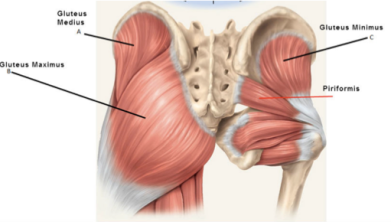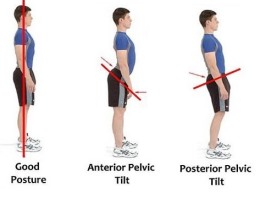In Part 1, we discussed what “tightness” really is (and what it isn’t), why mobility is so much more than just flexibility alone, and how to address mobility restrictions in the thoracic spine. In Part 2, we broke down the big bad hip flexor muscles. We’ll now discuss the hip flexor’s counterpart, the glute muscles of the posterior hip. The glutes are super important muscles for rowing. Not only are they responsible for a serious amount of power in the drive, but they are also major stabilizers of the hips and spine in all parts of the stroke and daily life. Much like the hip flexors, glutes can get fatigued, sore, and achey without any acute injury or condition, and are well worth the time in preventative massage, flexibility, mobility, and strength training for rowers to enjoy healthy bodies, good performance, and long careers.

Location: Posterior hip, “the butt muscles”
Rowing fault: Poor compression at the catch, poor leg drive, shortened reach during recovery
Importance of Glutes for Rowing
On the opposite side of hip flexors, the gluteal muscles are in a constant semi-stretched position during long bouts of sitting. Because full hip extension is never reached in rowing, the hip extensors are not often worked through their full range of motion. Inhibited compression, posterior pelvic tilt, and poor reach during the recovery are common results from gluteal restriction. Legs splayed during the recovery or at the catch is also common with rowers with tight glutes. Similar to hip flexor tightness, restricted glute muscles can be a culprit of back pain as the muscles all interact with the lower spine and hip region.
from gluteal restriction. Legs splayed during the recovery or at the catch is also common with rowers with tight glutes. Similar to hip flexor tightness, restricted glute muscles can be a culprit of back pain as the muscles all interact with the lower spine and hip region.
The Fix: Glutes for Rowing
With one leg crossed over the other, begin by foam rolling over the glute muscles broadly. If you find a trigger point with just the foam roller, work it for a couple minutes. Next, repeat with a tennis, softball, or lacrosse ball (ordered in ascending intensity). This should really allow you to dig in to the glute muscles, particularly the piriformis. Repeat this on both sides of the hip, then move on to static stretching. The pigeon stretch, figure-four, and lying glute stretch are the main stretches I use for tight glute muscles. I find that the specific trigger point work can be done at least once daily for an athlete who has a problem with their glutes, preferably more like 2-3 times so long as it doesn’t cause tenderness or bruising.
Video: Guided Glute Mobility
Strengthening Glutes for Rowing
First, we do a glute activation and hip warmup or a full body warmup before every strength training session, and I encourage rowers to do them before erging and rowing sessions as well. This sequence ensures that the hip flexors are being stretched and the glutes are being worked through a full range of motion at least once per training session. This helps keep them mobile before getting in a boat or on an erg. Including exercises that work the hips through a full range of extension motion is critical to strengthening the glute muscles. Banded good mornings, Romanian deadlifts, X-Band walks, and bilateral and unilateral hip extensions (thrusts or bridges) are always included in my rowing programs. Additionally, squats are great for gluteal development as well as leg drive power.
In order to enact significant, lasting change, a dedicated comprehensive program that involves all modalities is critical. I recommend focusing on one problem area at a time, at least one 10-15 minute session per day. Spending 20 minutes a day working on mobility for 2-3 weeks while watching a TV show, for instance, is a great way to progress toward full function. Foam roll, perform self-manual release on specific trigger points, and stretch, then make sure to perform additional strengthening exercises while implementing proper form into your rowing and erging training. Also, be cognizant of posture throughout the day. Many times, those with glute restrictions will spend much of the day in poor postural positions. Once full function is achieved, daily maintenance is simply performing daily activities from that now-strong position that your body can now adopt as normal positions.
Last updated November 2018.


Hi Will
Thanks for such a great site.
I am a coach in the north of England and I have been asked about the use of glutes in rowing. Your video on the glute activation is really helpful but I was wondering if you can help explain at what point in the rowing stroke they are used? Is it right at the catch when he balls of the feet are lifted or do they only come into play when the heels are pushing off the footboard? There is a lot of talk of ‘getting the heels down quickly’ after the catch – is this to engage the glutes? Any help would be much appreciated. Cheers David
Hi David,
Thanks very much. I’m glad my site has been helpful for you.
The gluteus maximus, which is what people tend to mean specifically when they talk about “glutes” in rowing, is the main hip extensor muscle. My core training article, linked below, includes an EMG research study of trunk muscle kinematics while erging. This study indicates that glute max activity peaks during the early/mid phase of the drive.
http://rowingstronger.com/2016/05/02/core-training-for-rowing/
There is also a British Rowing blog that you may be familiar with titled “How Engaging the Gluteal Muscles Can Improve Your Rowing Stroke.” The title suggests that they’re going to use the research study mentioned in the introduction to prove their point about glute activity. The study they cited includes no mention of glute muscle activity measurements nor any explicit mention of the glute muscle function at all. The blog authors appear to rely on subjective feedback and inference of what may be happening at a muscular level due to changes in footplate position. You can read the original study yourself here, or email me: https://pubmed.ncbi.nlm.nih.gov/27256844/
Most importantly, what the glutes do (or what any other muscle does) is all background information for coaches and rowers. I really try to limit my use of internal (ie. muscular) cues when rowers are rowing or erging. I do not talk about engaging glutes while rowing/erging for a few reasons.
#1. If the 2009 trunk muscle study mentioned above is accurate and glute activity peaks in the middle drive phase, then this is approximately one-third of the drive phase. The drive phase is half of the overall stroke cycle, the other half being recovery, so middle drive phase of highest glute activity is one-sixth of the overall stroke cycle. If the rowers are rowing 30spm, and let’s say they’re rowing a 1:1 drive:recovery ratio just to keep the math easy, then one-sixth of the stroke at 30spm is over and gone in less than 0.3 of a second. Realistically this number is less if rowers are rowing at more like a .75:1.25 ratio of drive-to-recovery, and even less if they’re rowing more than a 30spm. It is fallacious and counter-productive to think that athletes can or should focus on an internal cue for such a short amount of time and have a positive effect on their rowing performance.
#2. Even if athletes could process and act on this cue, research indicates that internal cueing has a negative effect on performance compared to external cueing. In one rowing study, a control of no cueing at all outperformed an internal cue of “pay attention to leg push and stretch.” https://journals.sagepub.com/doi/abs/10.1260/1747-9541.10.5.829?journalCode=spoa&
#3. The hip extension movement of rowing is smaller than in other sports due to the seated position of the athlete. Rowers are always moving between full flexion and partial extension. Even if the above items were mitigated, I’m not sure that a cue for hip extension is productive for an activity with such a short range-of-motion.
I think it is beneficial to take a divergent approach in the weight-room, where we are focused on muscular action and activity rather than rowing performance. Let’s teach glute activation through exercises that prioritize glute engagement–hip thrusts, hinge exercises, donkey kicks, band walks, etc.–and through compound exercises that require all these parts to work together. Maybe we use some internal cues here, since this is more of a process > performance environment, but without becoming reliant on them. Let’s teach different movements, and do things on land that we can’t do on water, rather than just pound away at stroke muscles. On the water, let the athletes put this into context for their own performance, not fill their heads with information that may not actually be helpful.
— Will
Dear Will,
I enjoy your articles so much! I have been rowing in a Masters group for almost 2 years. I have always been very active. I am 58 years old.
I have a hip issue I would love your feedback on. I have 75% of my left glut medius torn at it’s incertion. I initially had quite a bit of pain at that location.
My right thoracic paraspinals are very overdeveloped vs left.
While rowing;
-I have mod low back pain
-constantly feel the boat is leaning right
-Left quad and hip flexor discomfort pain after rowing
-Left hamstring fatigue more than right during long steady state or racing.
I am looking into surgical repair, however it is a fairly new procedure.
Any tips on how to correct the strength imbalance (visible decrease in muscle bulk of left thoracic paraspinals being one)?
Any thoughts injuries of this nature you have seen?
I am a PT, however I see neuro patients and ortho is a distant memory from school, or so it feels at times!
Thank you for taking the time.
Kindly,
Krista Stuerman
Hi Krista,
Thanks for writing in. As a PT, you know the value of working with someone with highly specialized knowledge. Rehab from injuries is PT realm, not strength coach territory. I recommend consulting with someone from my “Rowing PT” list here. Many of these fine folks are still offering virtual appointments, so you don’t have to live within direct proximity to get help.
http://rowingstronger.com/2021/03/22/rowing-physical-therapists-for-rowing-injuries/
~Will